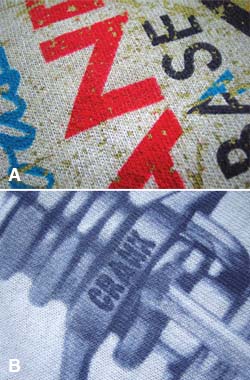Articles
Published
18 years agoon

Current trends in garment graphics validate the notion that what is old always seems to become new again. The most popular printing techniques right now are the ones that intentionally make designs look distressed, heavily washed, or worn out—new graphics that look old. These types of prints are in high demand right now, but the most successful garment screen printers are those who come up with unique ways to capitalize on consumers’ desires for these styles.
This article presents a gallery of special-effect garment graphics and explores the inks and printing techniques you can use as a foundation when creating your own soft-handed, distressed, and worn-looking graphics. Before we consider these samples, however, let’s take a closer look at the inks used to produce them.
Thinking of ink
Achieving a soft hand is a critical part of using special-effect inks. You can generally soften plastisols by simply adding a special extender base. Many different variations of soft-hand extenders are available, and the good news is that they seem to be improving all the time. However, adding too much of these extenders tends to weaken the finished color. The trade-off is between the extreme softness possible and the strength of the color. Deep, rich colors, like navy blue, are especially prone to weakening. This situation leaves the garment screen printer looking for an extender that provides the greatest softness in the smallest amount.
Ink manufacturers have responded to this demand by developing new plastisol inks. This new generation of formulations produces an extremely soft feel and can maintain a very acceptable richness of color. Opaque versions of these soft-hand plastisols are now available and can produce the same effect on dark shirts. These new inks are comparable to the hand of water-based and discharge inks and have the added benefit of being much easier to use and control. Soft hand is important when creating the garment graphics shown in the examples in this article.
New, more printer-friendly water-based inks also are available. They’re designed around simple color-matching systems, and many have been designed to eliminate the old problems of inks drying in the screens or in the open areas of the image. Extenders are available to make the print even softer where particular colors allow it.
As an alternative, a discharge underprint can be used where color brightness is a concern. Ensure that you use enough heat and time in the dryer to fully remove the water and associated chemicals from the ink. As with any water-based ink, the flash times increase, which can slow down production speeds. One trick I use is to put two flash units in sequence after the discharge underprint, thereby decreasing the time the printed garment must stay indexed under each flash unit. This method usually works well because the water-based colors on top of the underprint do not usually require any flashing. Using two flash units can also help to fully discharge the underprint.
Once you’ve determined which inks are best suited to the application, you can experiment with different techniques in prepress and during pre-production tests. The most common approach for producing a distressed looking design is to create a simulated crackle pattern in a standard graphics program and place the result as needed into a logo or design. Many printers have used this method, so you should probably avoid doing the same unless you can do it exceptionally well.
Even though distressed prints are popular, I believe there is still a definite place for raised, textural prints that rely on more traditional specialty inks and techniques. Some examples of how to simulate a very realistic leather patch and other effects are shown in the gallery.
Make the most of your special effects
The demand for new and innovative printing techniques of all types will never fade. Once you understand some of the methods shown here, adapt the processes to your own shop. There are many different ways to produce similar effects, and every screen printer will need to adjust these practices for best results. Many of the companies I work with on these types of prints take the basics of the techniques and alter or expand upon them in exciting ways that I hadn’t considered when I developed the methods. If you take the time to build experience with special-effect printing, you may just be the printer who sets the next huge trend.
About the author
Michael Beckman holds a bachelor of fine art degree in printmaking from Northern Arizona University, where he was the master printer for the school’s visiting-artist program and an honors graduate. Involved in the screen-printing industry for more than 18 years, he has worked for many top printing operations in positions ranging from artist and art director to technical manager and general manager. Beckman serves as a technical consultant to the industry and is credited with the original development of high-density ink and printing processes, as well other specialty-decorating methods. He can be reached at MB Screen Printing Inc. in Portland, OR by e-mailing mbsp@comcast.net.

Subscribe

Magazine
Get the most important news
and business ideas from Screenprinting Magazine.
Most Popular
-

 Case Studies2 months ago
Case Studies2 months agoHigh-Density Inks Help Specialty Printing Take Center Stage
-

 Art, Ad, or Alchemy2 months ago
Art, Ad, or Alchemy2 months agoF&I Printing Is Everywhere!
-

 Andy MacDougall2 months ago
Andy MacDougall2 months agoFunctional and Industrial Printing is EVERYWHERE!
-

 Columns3 weeks ago
Columns3 weeks ago8 Marketing Mistakes Not to Make When Promoting Your Screen Printing Services Online
-

 Editor's Note3 weeks ago
Editor's Note3 weeks agoLivin’ the High Life
-

 Marshall Atkinson3 weeks ago
Marshall Atkinson3 weeks agoHow to Create a Winning Culture in Your Screen-Printing Business
-

 Thomas Trimingham2 months ago
Thomas Trimingham2 months ago“Magic” Marketing for Screen Printing Shops
-

 News & Trends2 months ago
News & Trends2 months agoWhat Are ZALPHAS and How Can You Serve Them in Your Print Business?






